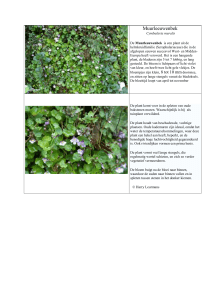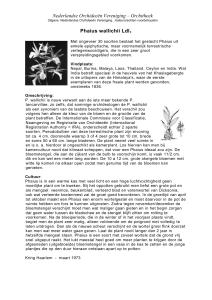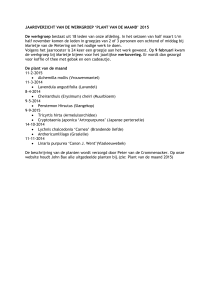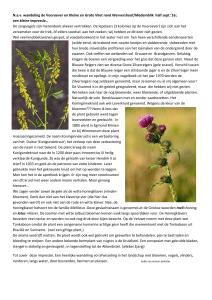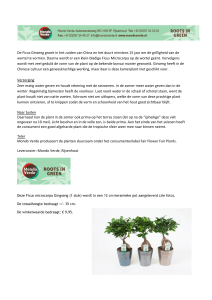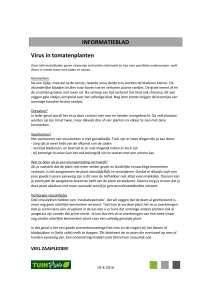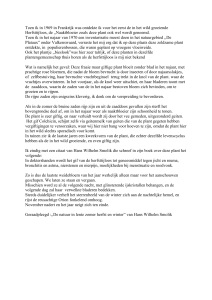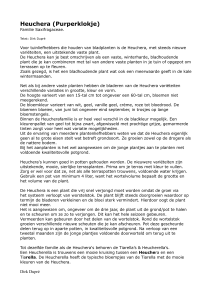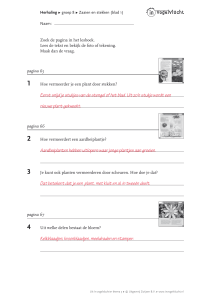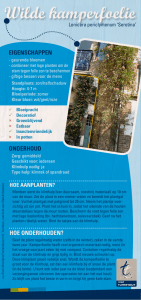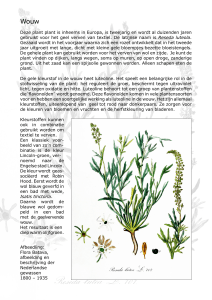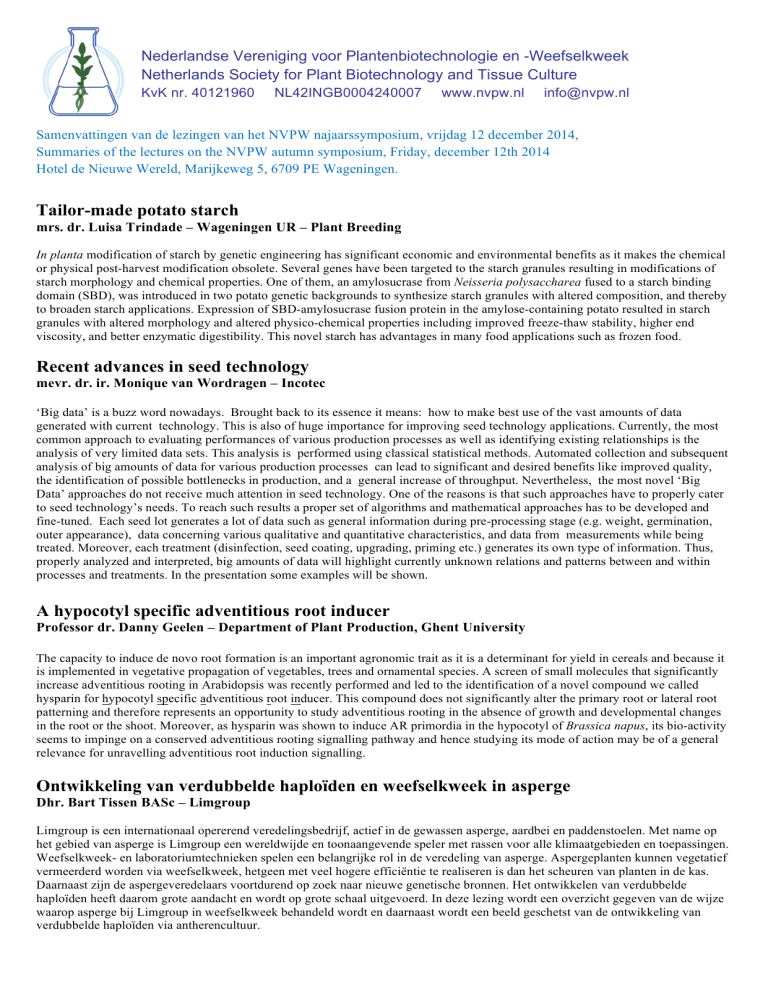
Nederlandse Vereniging voor Plantenbiotechnologie en -Weefselkweek
Netherlands Society for Plant Biotechnology and Tissue Culture
KvK nr. 40121960
NL42INGB0004240007
www.nvpw.nl
[email protected]
Samenvattingen van de lezingen van het NVPW najaarssymposium, vrijdag 12 december 2014,
Summaries of the lectures on the NVPW autumn symposium, Friday, december 12th 2014
Hotel de Nieuwe Wereld, Marijkeweg 5, 6709 PE Wageningen.
Tailor-made potato starch
mrs. dr. Luisa Trindade – Wageningen UR – Plant Breeding
In planta modification of starch by genetic engineering has significant economic and environmental benefits as it makes the chemical
or physical post-harvest modification obsolete. Several genes have been targeted to the starch granules resulting in modifications of
starch morphology and chemical properties. One of them, an amylosucrase from Neisseria polysaccharea fused to a starch binding
domain (SBD), was introduced in two potato genetic backgrounds to synthesize starch granules with altered composition, and thereby
to broaden starch applications. Expression of SBD-amylosucrase fusion protein in the amylose-containing potato resulted in starch
granules with altered morphology and altered physico-chemical properties including improved freeze-thaw stability, higher end
viscosity, and better enzymatic digestibility. This novel starch has advantages in many food applications such as frozen food.
Recent advances in seed technology
mevr. dr. ir. Monique van Wordragen – Incotec
‘Big data’ is a buzz word nowadays. Brought back to its essence it means: how to make best use of the vast amounts of data
generated with current technology. This is also of huge importance for improving seed technology applications. Currently, the most
common approach to evaluating performances of various production processes as well as identifying existing relationships is the
analysis of very limited data sets. This analysis is performed using classical statistical methods. Automated collection and subsequent
analysis of big amounts of data for various production processes can lead to significant and desired benefits like improved quality,
the identification of possible bottlenecks in production, and a general increase of throughput. Nevertheless, the most novel ‘Big
Data’ approaches do not receive much attention in seed technology. One of the reasons is that such approaches have to properly cater
to seed technology’s needs. To reach such results a proper set of algorithms and mathematical approaches has to be developed and
fine-tuned. Each seed lot generates a lot of data such as general information during pre-processing stage (e.g. weight, germination,
outer appearance), data concerning various qualitative and quantitative characteristics, and data from measurements while being
treated. Moreover, each treatment (disinfection, seed coating, upgrading, priming etc.) generates its own type of information. Thus,
properly analyzed and interpreted, big amounts of data will highlight currently unknown relations and patterns between and within
processes and treatments. In the presentation some examples will be shown.
A hypocotyl specific adventitious root inducer
Professor dr. Danny Geelen – Department of Plant Production, Ghent University
The capacity to induce de novo root formation is an important agronomic trait as it is a determinant for yield in cereals and because it
is implemented in vegetative propagation of vegetables, trees and ornamental species. A screen of small molecules that significantly
increase adventitious rooting in Arabidopsis was recently performed and led to the identification of a novel compound we called
hysparin for hypocotyl specific adventitious root inducer. This compound does not significantly alter the primary root or lateral root
patterning and therefore represents an opportunity to study adventitious rooting in the absence of growth and developmental changes
in the root or the shoot. Moreover, as hysparin was shown to induce AR primordia in the hypocotyl of Brassica napus, its bio-activity
seems to impinge on a conserved adventitious rooting signalling pathway and hence studying its mode of action may be of a general
relevance for unravelling adventitious root induction signalling.
Ontwikkeling van verdubbelde haploïden en weefselkweek in asperge
Dhr. Bart Tissen BASc – Limgroup
Limgroup is een internationaal opererend veredelingsbedrijf, actief in de gewassen asperge, aardbei en paddenstoelen. Met name op
het gebied van asperge is Limgroup een wereldwijde en toonaangevende speler met rassen voor alle klimaatgebieden en toepassingen.
Weefselkweek- en laboratoriumtechnieken spelen een belangrijke rol in de veredeling van asperge. Aspergeplanten kunnen vegetatief
vermeerderd worden via weefselkweek, hetgeen met veel hogere efficiëntie te realiseren is dan het scheuren van planten in de kas.
Daarnaast zijn de aspergeveredelaars voortdurend op zoek naar nieuwe genetische bronnen. Het ontwikkelen van verdubbelde
haploïden heeft daarom grote aandacht en wordt op grote schaal uitgevoerd. In deze lezing wordt een overzicht gegeven van de wijze
waarop asperge bij Limgroup in weefselkweek behandeld wordt en daarnaast wordt een beeld geschetst van de ontwikkeling van
verdubbelde haploïden via antherencultuur.
Automated phenotyping as a tool for assessing plant performance
dr. Marcus Jansen - LemnaTec GmbH
Plant biotechnology and tissue culture aim at developing plant varieties with novel and beneficial properties. Candidate plants need
thorough characterization in order to assess whether they carry the desired properties and to exclude undesired penalties in
performance. Phenotyping delivers comprehensive characterization of plants in terms of growth, morphology, water status,
photosynthesis, or pigments. Moreover, phenotypic studies reveal plant responses to environmental factors and cultivation conditions.
LemnaTec provides tools for phenotyping at lab scale, which is frequently the first step when new candidates are developed in
biotechnology or tissue culture. LemnaTec delivers equipment for following steps in greenhouse and field trials, too. Our Scanalyzer
products accompany the whole phenotyping chain from lab to field with automated non-invasive technology and a comprehensive
software package for data analysis.
The sleepless Tomato
dhr. dr. ir. Wim van Ieperen – Wageningen UR
Hebben planten een dagelijkse periode rust nodig? Deze vraag houdt onderzoekers al decennia lang bezig en een reden om te
vermoeden dat dit het geval zou kunnen zijn is dat nogal wat plantensoorten niet tegen continue licht (24h licht/24h) bestand zijn. Zo
vertonen alle moderne tomaten cultivars onder continue licht sterke bladvergeling die bij langdurige blootstelling de plant fataal is. De
reden hiervoor was tot nog toe onopgehelderd. Uit recent promotieonderzoek1 is gebleken dat wilde tomaten soorten wél bestand zijn
tegen continue licht en dat een enkel gen (CAB-13) zeer waarschijnlijk verantwoordelijk is. Na inkruisen van CAB-13 in een aantal
moderne tomatenrassen werden deze ook tolerant voor continue licht. Uit een praktijkproef in kassen bleek dat deze planten niet
alleen continue (24/7) licht konden verdragen, maar ook twintig procent meer productie opbrachten. (1 Velez-Ramirez, A. I., van
Ieperen, W., Vreugdenhil, D., van Poppel, P. M. J. a., Heuvelink, E., & Millenaar, F. F. (2014). A single locus confers tolerance to
continuous light and allows substantial yield increase in tomato. Nature Communications, 5, 1–13. doi:10.1038/ncomms5549)
Roots, the hidden half - The use of genetic variation in roots to improve productivity
Dr. ir. Peter van de Pol - Plant Research Overberg B.V.
In crops where own rooted cuttings are used, the plants can be considered as an unintentional compromise between the different
functions of shoots and roots. Variation in root quality between cultivars of Chrysanthemum showed 30-60% differences in
production. Worldwide, around 150 million rootstocks for cut roses are yearly used. We developed new rootstocks for roses giving 1020% more biomass. March 2014 a Scientific Symposium on Vegetable Grafting was held in China, with 250 participants from 21
countries (without The Netherlands!). Question is: What are the options for other crops?
Gerichte mutagenese in aardappel
Dr. ir. Jan Schaart – Wageningen UR - Plant Breeding
Mutatieveredeling is van oudsher en belangrijke methode om nieuwe variatie te genereren in gewassen en heeft geresulteerd in vele
nieuwe plantenrassen met nieuwe eigenschappen. Bij traditionele mutatieverdeling worden mutaties in het plantengenoom
geïnduceerd door bestraling of door behandeling met chemische mutagentia, waarbij het hele genoom verzadigd wordt met mutaties.
Vervolgens moeten uit de duizenden gemuteerde planten de gewenste mutante lijnen worden geselecteerd en door herhaald
terugkruisen met de ouderplant moeten ongewenste mutaties worden verwijderd. Traditionele mutatieveredeling is een erg
bewerkelijk en langdurig proces en verloopt voor veel soorten moeizaam vanwege een lange generatietijd (bv bij fruitbomen,
bolgewassen) of door complexe genetica (polyploïdie, heterozygotie, zelfincompatibiliteit). Nieuwe gerichte mutatiemethoden kunnen
hier uitkomst bieden. Met plaats-specifieke nucleases, zoals Zinc Finger Nucleases (ZFNs), TALENs en CRISPR-Cas9, kunnen heel
gericht mutaties aangebracht worden in principe elk gen. Bij WUR-Plant Breeding hebben we de toepassing van ZFNs uitgetest voor
de mutagenese van het starch branching enzym II gen (sbeII) in tetraploïde aardappel. Introductie van ZFNs in aardappel gericht tegen
sbeII resulteerde in verschillende mutante aardappellijnen waarin het sbeII gen gedeleteerd was. Deletie van een gen lijdt vaak tot
verlies van genfunctie. Omdat in tetraploïde planten van elk gen vier kopieën (allelen) aanwezig zijn, is het belangrijk dat alle vier
allelen gedeleteerd worden om de genfunctie binnen een plant volledig uit te schakelen. Wij laten zien dat dit in tetraploïde aardappel
met ZFNs mogelijk is in één enkele mutatie stap.

